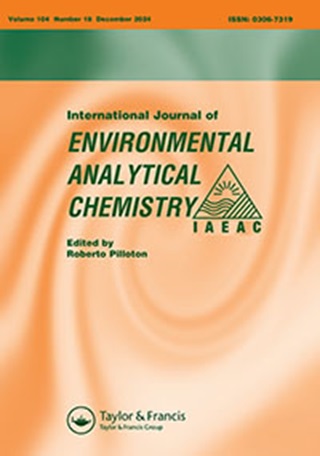Solid phase extraction of Aflatoxin M1 in milk samples by graphene oxide-poly-L-lysine nanocomposite followed by HPLC
IF 2.5
4区 化学
Q3 CHEMISTRY, ANALYTICAL
International Journal of Environmental Analytical Chemistry
Pub Date : 2023-10-01
DOI:10.1080/03067319.2023.2262394
引用次数: 0
Abstract
ABSTRACTAn efficient, novel and green Graphene Oxide-Poly-L-Lysine (GO-PLL) adsorbent was successfully synthesised and used for solid-phase extraction of aflatoxin M1 (AFM1) in liquid milk samples followed by high performance liquid chromatography (HPLC) equipped with fluorescence detector (FLD). The synthesised adsorbent was characterised by Fourier Transform Infrared Spectrophotometry (FT-IR), Field Emission Scanning Electron Microscopy (FESEM), Energy-dispersive X-ray spectroscopy (EDX) and X-Ray diffraction (XRD) analysis. Different parameters affecting the recovery percentage of AFM1 including pH of sample solution, amounts of adsorbent, contact time and desorbent solution (types and volume) were completely investigated and optimised. It was found that, with an enrichment factor of 15.2, the calibration curve is linear in the range of 0.05–4.00 ng ml−1 AFM1 and the limit of detection (LOD) and limit of quantification (LOQ) values were 0.019 and 0.063 ng mL−1, respectively. The relative standard deviations (RSDs) ranged from 4.5% to 5.7% and 4.2% to 6.7% for intra-day and inter-day variations, respectively. Finally, the proposed solid-phase extraction method was successfully applied for determination of trace levels of AFM1 in different milk samples.KEYWORDS: Aflatoxin M1Graphene Oxide-Poly-L-Lysine (GO-PLL) adsorbentHPLCmilk sample AcknowledgmentsThe authors wish to thank the University of Neyshabur for the financial support of this project (grant number: 14703).Disclosure statementNo potential conflict of interest was reported by the author(s).Additional informationFundingThis work was supported by the Neyshabur University of Medical Sciences [grant number:14703].氧化石墨烯-聚赖氨酸纳米复合物-高效液相色谱固相萃取牛奶样品中的黄曲霉毒素M1
摘要成功合成了一种高效、新型、绿色的氧化石墨烯-聚l -赖氨酸(GO-PLL)吸附剂,并采用荧光检测器(FLD)高效液相色谱(HPLC)法对液态奶样品中的黄曲霉毒素M1 (AFM1)进行固相萃取。采用傅里叶变换红外光谱(FT-IR)、场发射扫描电镜(FESEM)、能量色散x射线能谱(EDX)和x射线衍射(XRD)对合成的吸附剂进行了表征。对样品溶液pH、吸附剂用量、接触时间和脱附液(种类和体积)等影响AFM1回收率的参数进行了全面研究和优化。富集系数为15.2,在0.05 ~ 4.00 ng ml−1 AFM1范围内呈线性关系,检出限和定量限分别为0.019和0.063 ng ml−1。相对标准偏差(rsd)在日内和日内变化范围分别为4.5% ~ 5.7%和4.2% ~ 6.7%。最后,将所建立的固相萃取法成功地应用于不同牛奶样品中AFM1的痕量测定。关键词:黄曲霉毒素m1氧化石墨烯-聚l -赖氨酸(GO-PLL)吸附聚l -赖氨酸(GO-PLL)牛奶样品披露声明作者未报告潜在的利益冲突。本研究由Neyshabur医学科学大学资助[批准号:14703]。
本文章由计算机程序翻译,如有差异,请以英文原文为准。
求助全文
约1分钟内获得全文
求助全文
来源期刊
CiteScore
5.90
自引率
7.70%
发文量
373
审稿时长
4.4 months
期刊介绍:
International Journal of Environmental Analytical Chemistry comprises original research on all aspects of analytical work related to environmental problems. This includes analysis of organic, inorganic and radioactive pollutants in air, water, sediments and biota; and determination of harmful substances, including analytical methods for the investigation of chemical or metabolic breakdown patterns in the environment and in biological samples.
The journal also covers the development of new analytical methods or improvement of existing ones useful for the control and investigation of pollutants or trace amounts of naturally occurring active chemicals in all environmental compartments. Development, modification and automation of instruments and techniques with potential in environment sciences are also part of the journal.
Case studies are also considered, particularly for areas where information is scarce or lacking, providing that reported data is significant and representative, either spatially or temporally, and quality assured. Owing to the interdisciplinary nature of this journal, it will also include topics of interest to researchers in the fields of medical science (health sciences), toxicology, forensic sciences, oceanography, food sciences, biological sciences and other fields that, in one way or another, contribute to the knowledge of our environment and have to make use of analytical chemistry for this purpose.

 求助内容:
求助内容: 应助结果提醒方式:
应助结果提醒方式:


